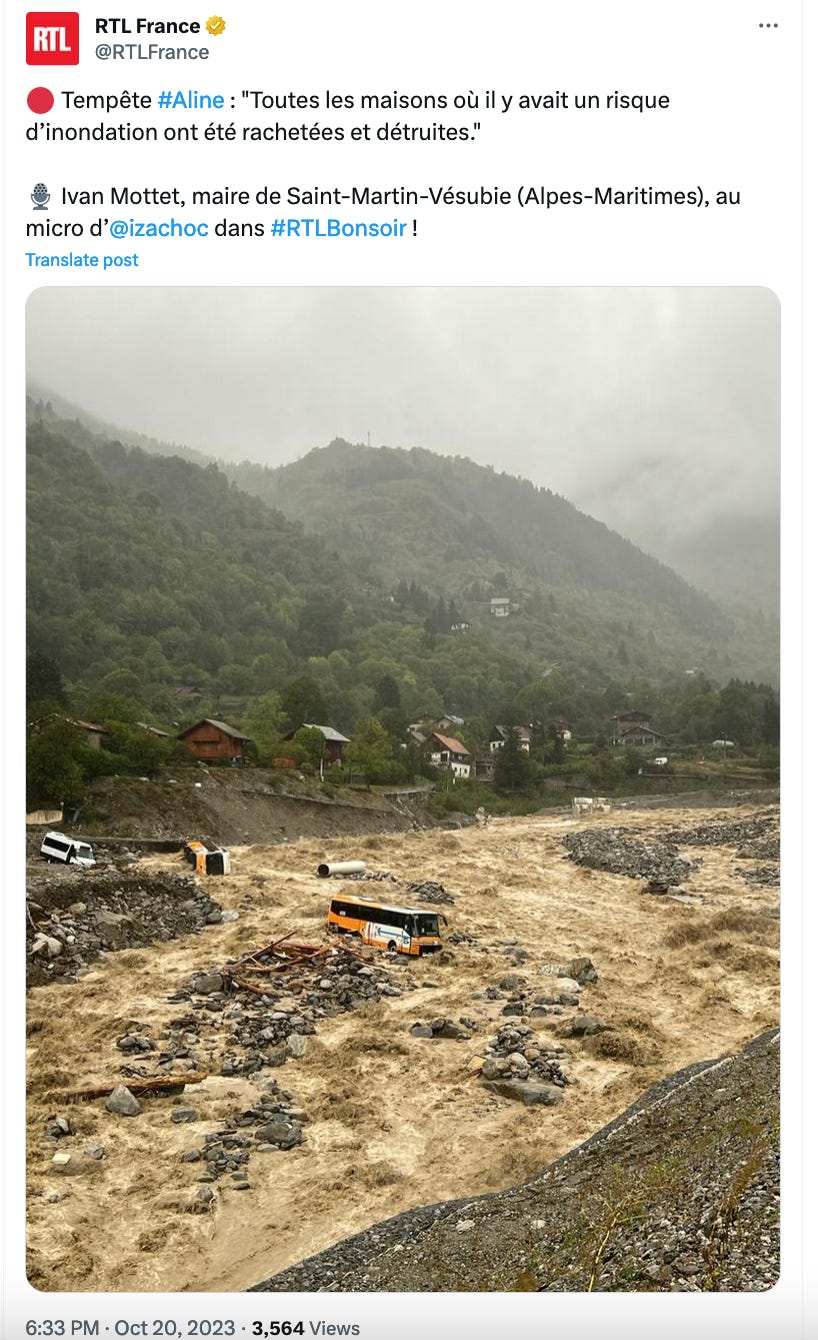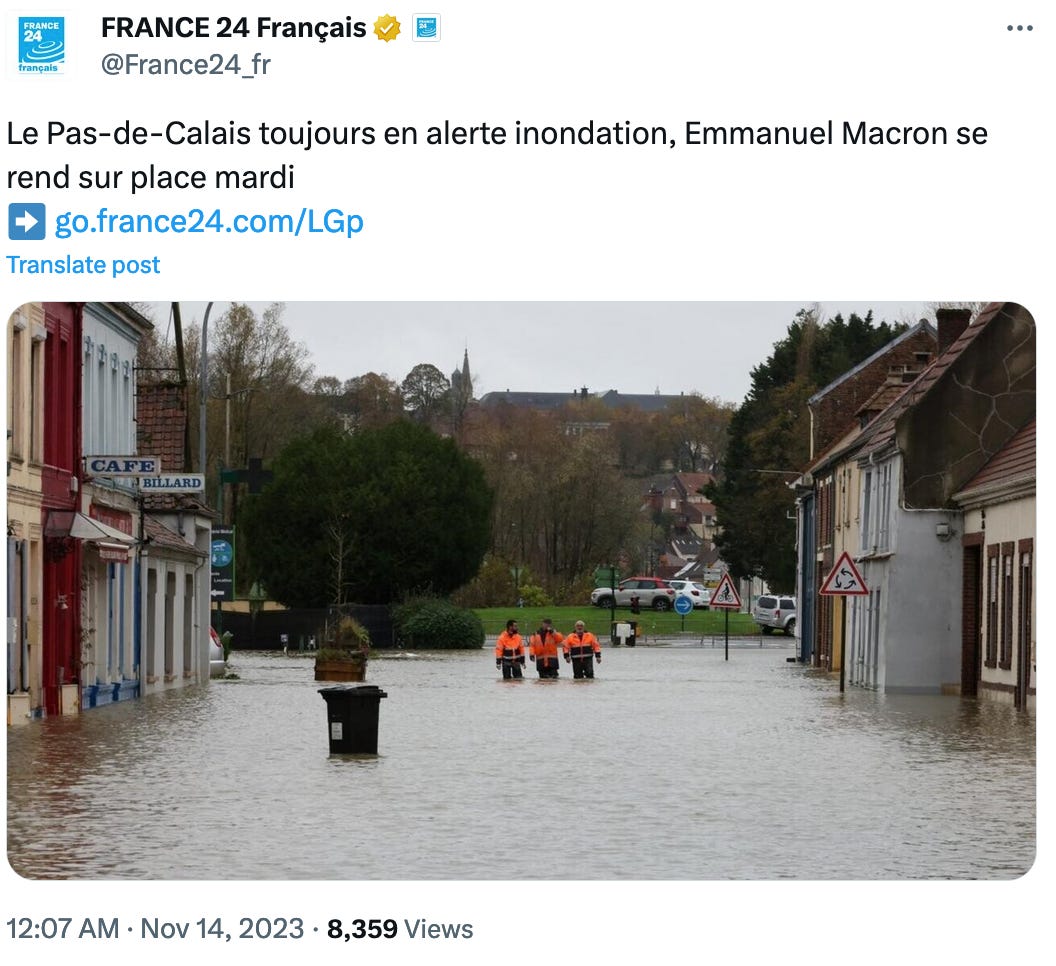Inundation Nation: Who'll Stop The Rain?
Record rainfall is the latest extreme weather to hit France.
After the wettest autumn on record, it is hard to know if the latest severe weather warning is good news or bad news. More precipitation is being forecast across France this weekend, but because it’s borderline freezing, it could be snow (yeah!), or it could be more rain (boo!), or it could be some hellish mix of ice and slush (zoinks!).
Whatever it turns out to be, it’s been a brutal few weeks weather wise, particularly in the North of France. Between October 18 and November 16, an average of 237.3 millimeters fell, according to the national weather service Météo-France. This was the most rain ever to fall over 30 days, crushing the previous record of 187.1 millimeters between January 13 and February 11, 1988.
The rain became almost a daily presence starting in mid-October. On October 18, the Aline storm hit southeast France in regions such as Nice and Cannes, dumping as much as 200 millimeters of rain in some places, causing flooding, triggering mudslides, knocking out bridges and roads, and cutting electricity. Several villages were completely inaccessible by road. A natural disaster was officially declared for ten communities and local governments established a €15 million emergency relief fund.
In early November, the storm Ciaran hit northwest France with hurricane-force winds. Three people were killed, at least 47 others were seriously injured, 684,000 homes lost electricity, and there was widespread property damage of an estimated €375 million.
Two days later, the Domingos storm swept across France, less intense but still with gusts reaching hurricane levels. As the storm hit, 114,000 homes in the Normandy and Brittany regions were still without power from Ciaran. A worker for the power company who was on a crew trying to re-establish power from the first storm died when he was electrocuted during Domingos, according to France 24.
And then came Elisa in mid-November, hitting the Calais region with another 70 millimeters of rain and tropical storm-level winds. The storm forced schools in the region to close as some villages that were still underwater from the previous storms braced for more. During this rain-soaked reign of terror, Calais was the hardest hit region of France, with 295 millimeters of water. With grounds already soaked from previous storms, homes and businesses flooded while rivers spilled over their banks.
Rain, Rain, Go Away…
Calais is in the Hauts-de-France, the northernmost part of France that shares a border with Belgium. It is a famously rainy region. This was memorialized in the popular 2008 film comedy Bienvenue chez les Ch'tis (the nickname for the people who live there). The second a driver crosses the border into the region, he’s immediately caught in a torrential downpour.
Even so, Meteo France reported that Hauts-de-France experienced the equivalent of 4 months of rain in 10 days. Between October 18 and November 11, it rained every day in the region. Canals were closed to all boats for several weeks and more than 1,000 people were evacuated to shelters.
On November 14, President Macron toured some flooded regions and declared a natural disaster for 250 municipalities, including 214 in the Calais region. The national government also created a €50 million relief fund.
And then this past week, severe rains returned, placing the Calais region on high alert after a few days of sunshine had offered a brief glimmer of hope. “Some residents have experienced this three times,” Fabienne Berquier, president of the Pas-de-Calais Red Cross, told L’OBS newspaper.
The Red Cross dispatched 150 volunteers to the region this week, including a team to provide emergency psychological counseling. “People need to talk and ask us lots of questions. We don’t provide solutions, but we listen. They tell us that in twenty years, they have never experienced this,” Berquier told the newspaper.
Cracking Up
Just after the latest round of storms, Météo-France delivered its annual report on weather trends, which noted that 2023 would be the 2nd warmest year in France since 1900, falling just short of the average temperatures in 2022. The agency also noted that 9 of the 10 warmest years since 1900 have come since 2010.
Now, one might be tempted to think: Hey, doesn’t France need all this rain after a long, dry summer? Yes, but not at this intensity when the ground is too saturated to absorb it. In fact, this creates its own problems.
The nation’s insurance companies have said that the cost of natural disasters from storms and drought rose to €10 billion in 2022, well above the annual average of €3.5 billion. But those numbers could still climb. In September, the government retroactively declared a natural disaster for 1,022 communities that suffered drought-related damage from the summer of 2022, making them eligible for insurance claims.
There is an important nuance in how the government made that declaration. Officials blamed not just the drought, but the dynamic of soil alternating between dryness and then being re-hydrated by rainfall. By moving from one extreme to another, the ground is becoming unstable, leaving homes and buildings increasingly vulnerable to damage.
Indeed, in early October, the government issued a report stating that 11 million homes were at risk of experiencing severe cracking as the result of this drought cycle that causes the soil to shrink and then swell (phénomène de retrait-gonflement des argiles). That’s more than 1 out of 4 housing units in France that could suffer cracking so severe that they become uninhabitable.
Interior Minister Gerald Darminan declared: “We must strengthen our action to better help our fellow citizens who are victims.”
But really, there’s not much the government can do. The report mainly called for reforms related to declaring natural disasters and requirements for insurance companies to recognize and process claims, as well as more detailed disclosures by people selling homes. And for better monitoring of soil conditions with more monitoring stations.
As for stopping the extreme weather that’s the underlying cause? French insurance companies said this unstable soil caused almost €2.9 billion worth of those €10 billion in claims last year. They projected this figure would triple by 2050 as drought and heavy rain become more frequent and extreme.
Chris O’Brien
Le Pecq






